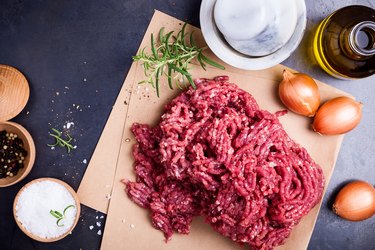
If you don't have a meat grinder, you won't be able to make ground meat the way you see it in the grocery store, but you can grind meat in a blender before or after cooking it. The more powerful your blender, the better the end result.
Preparing Meat for Grinding
Video of the Day
If you are grinding raw meat in the blender, you want to keep it as cold as possible throughout the process so you don't encourage bacterial growth in the meat. The USDA Food Safety and Inspection Service says any bacteria on the surface of the meat will be present throughout the meat once it is processed through a blender, food processor or grinder.
Video of the Day
Use a sharp knife to remove fat, bones, skin, gristle and connective tissue from the meat. According to the University of Georgia Extension, sausage making is a wonderful way to make use of tougher, low-value cuts of meat.
To make it easier to grind meat in the blender, cut all the pieces as uniformly as possible, making them about an inch or so in size, to keep them from being too large to easily break down.
To ensure the meat stays below 40 degrees Fahrenheit during the grinding process, you can keep it in a bowl of ice while you work or in a metal bowl that has been frozen for a few hours before you start to work.
It's also possible to lay the cut pieces of meat onto a baking sheet lined with wax paper and place them, along with the blender blade, in the freezer for a couple of hours to get them nice and cold before you start grinding the meat.
Read more: Is Ground Beef Good for Your Diet?
Meat Blender: Grind With Ease
Unless you're planning on grinding meat on a regular basis, you can use your blender to get the job done. Lower-powered motors may have trouble grinding the meat, so it may take more time. To get the best result, work in batches to make sure you don't overload your blender.
Place a small amount of the pieces of meat into your blender. Add the lid. Use the "Chop" setting. Run the blender for 20 to 30 seconds. Remove the lid and check the consistency of the meat. Continue running the blender's chop cycle until you've reached the desired consistency. Run it for short periods of time so you don't end up over processing the meat.
If you want a smooth texture for a pureed diet or baby food, you'll need to chop it in the blender longer than you would for making sausage, which requires a coarse texture. The University of Virginia Health System says homemade pureed foods often taste better, making it easier to tolerate the diet if you're having trouble with chewing, swallowing or digesting your food.
Using a Food Processor
If you don't want to use a blender, you can also grind meat with a food processor instead of a meat grinder. It will work much the same way as using a blender.
You'll want to use the standard food processor blade, known as the S-shaped blade or the Sabatier blade. When used on the "Pulse" setting, this blade mixes and chops. When you run it continuously, the blades blend and puree. Save the shredding disc for grating zucchini for zucchini bread or grating carrots for coleslaw or carrot cake.
Pulse the meat until it reaches the consistency you need for your recipe. If it's raw, be sure to cook it until it reaches the appropriate internal temperature. According to FoodSafety.gov, if the ground meat is made with beef, pork, veal, lamb or a mixture of those, it needs to be cooked until it reaches 160 F internally. If you're working with ground turkey or chicken, it needs to be cooked until it reaches 165 F.